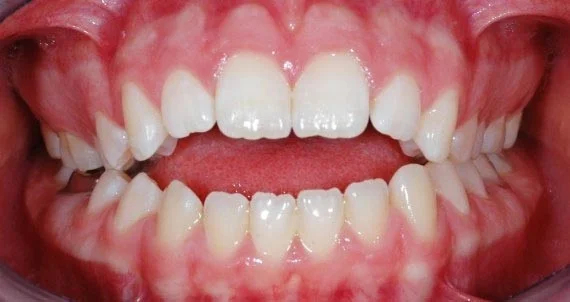Last Updated on: 3rd December 2025, 10:20 am
Tongue thrust affects teeth by pushing them forward and creating problems like open bite or misalignment. It also affects speech because the tongue is not in the right position, which can make some sounds difficult to pronounce.
The tongue is a small but very strong organ that works all day long. It helps with chewing, breathing, swallowing, and speaking, and its muscles move constantly even when we do not notice it, which is why, although it is such a small organ compared to others, it is known to be the strongest in the human body.
Swallowing is the act by which food and saliva pass from the mouth to the stomach and is something done between 1,000 and 2,000 times per day, and sometimes this process is not done in the correct way, leading to an atypical swallow.
In this article, you will learn about one of the most common problems: tongue thrust or protrusion of the tongue.
What is tongue thrust?
Tongue thrust is an oral habit where:
- The tongue pushes the front teeth when speaking or swallowing.
- In some cases, it also pushes the back teeth.
- It can happen in children and adults, affecting the bite, facial growth, and speech.
What are the stages of tongue thrust?
Tongue thrust in babies (up to 6 months of age)
In babies, this swallowing pattern is normal. They place the tongue on the gum to swallow, and since they have no teeth, this does not cause any problems.
Tongue thrust in children and adults
After the first teeth come in, the tongue should touch the palate when swallowing and then move down to push the food toward the throat.
If the child grows and continues pushing the tongue forward, this can cause:
- Teeth moving or leaning forward
- Open bite
- Speech and breathing problems
How is tongue thrust classified?
Tongue thrust can be divided into four types, and depending on the severity, it can cause different dental problems.
Type I: Non-deforming tongue thrust
This habit does not cause big changes in the teeth or bite. The pressure is light and can be corrected easily if found early.
Type II: Anterior deforming tongue thrust
The tongue pushes the front teeth, causing an open bite, the teeth move forward, and sometimes a posterior crossbite appears.
Type III: Lateral deforming tongue thrust
The tongue pushes the teeth on the sides, creating a posterior open bite, crossbite, and even a deep bite that affects dental balance.
Type IV: Anterior and lateral deforming tongue thrust
This combines the effects of Types II and III, producing open bite in the front and back, forward teeth, and crossbite.
What are the signs of tongue thrust?
Tongue thrust affects more than the teeth. Other signs include:
- High or narrow palate
- Open lips and incorrect position of the tongue when at rest
- Speech problems: orofacial myofunctional disorders
- Difficulty chewing
Early detection allows faster and more effective treatment.
Why does tongue thrust happen? What causes it?
Tongue thrust can be caused by several factors:
Habits of sucking
Thumb sucking or long use of bottles and pacifiers after 4–5 years can lead to tongue thrust.
Mouth anatomy
Some physical conditions can favor this habit:
- Short lingual frenulum (tongue-tie) or ankyloglosia
- Large tonsils
- Narrow palate
- Very large tongue
Environmental factors
Allergies, nasal congestion, and mouth-breathing can change tongue posture and create tongue thrust.
What is the treatment for tongue thrust?
Treatment is similar for children and adults. Depending on the severity, one or more steps may be needed.
Initially, it will focus on eliminating the cause for the tongue protrusion; after that, the habit will be corrected, and finally, any dental problems that arose from the tongue thrust will be fixed.
Can the cause of tongue thrust be removed?
Yes. The first step is to find and fix the cause:
- Sucking habits
- Breathing or allergy problems
- Anatomical conditions
How is the tongue habit corrected?
Special therapies are used, such as:
- Myofunctional therapy
- Speech and breathing therapy
- Appliances that help guide the tongue into the correct position
What treatments correct the dental problems caused by tongue thrust?
- Orthodontics to fix open bite, crossbite, or deep bite
- Functional orthodontics and orthopedic treatments to guide growth and correct dental alignment
These treatments are highly effective, and success depends on the patient’s commitment and support from family.
Why is it important to visit the dentist regularly?
Regular dental visits are very important when dealing with tongue thrust.
- The dentist is often the first professional to notice early signs of the habit, changes in the bite, or problems with tongue posture.
- They can guide parents and patients on what steps to follow, recommend the right specialist for therapy, and monitor dental growth to avoid future complications.
Early dental visits prevent more complex, painful, and expensive treatments later.
What products help take care of the mouth and tongue?
Good daily oral care supports tongue thrust treatment and keeps the mouth healthy. Dentists often recommend:
- Soft toothbrushes for children and adults
- Fluoride toothpaste to protect enamel
- Alcohol-free mouthwash for healthy gums
- Tongue cleaners or scrapers to remove bacteria
- Dental floss or interdental brushes to prevent plaque buildup
These simple products help maintain good hygiene, support correct tongue posture, and improve the results of therapy and orthodontic treatment.
How can tongue thrust be prevented and treated?
The best way to prevent and treat tongue thrust is early detection. This condition can be seen at a very young age, so parents should take children to the dentist as soon as the first teeth appear.
Regular dental checkups help find the habit early, guide the family, and start treatment before problems get worse.
Early prevention and consistent dental care are the best way to protect a healthy mouth and proper oral development.
Frequently Asked Questions
Does tongue thrust affect speech?
Can adults correct tongue thrust?
How long does it take to correct tongue thrust?
Are there exercises to correct tongue thrust at home?
Can tongue thrust recur after treatment?
Voice and Search (Q&A)
How can a dentist help with tongue thrust?
Dentists check your tongue and bite, recommend therapy or appliances, and guide your progress to prevent problems.
How can I tell if I have tongue thrust?
Look for teeth pushed forward, lips slightly open, or tongue touching teeth when swallowing. Speech issues like a lisp can also be a sign.
How do I fix tongue thrust?
Therapy, exercises, and dental appliances can help correct tongue posture. Sometimes braces are needed to fix teeth alignment as well.
Share
References
1. American Speech-language-hearing association. (n. d). Orofacial Myofunctional Disorders. ASHA. https://www.asha.org/public/speech/disorders/orofacial-myofunctional-disorders/
2. Cleveland Clinic. (2025, June 2). Tongue thrust. https://my.clevelandclinic.org/health/diseases/tongue-thrust
3. Gotter, A. (2020, March 24). Tongue Thrust in Children and Adults: What You Should Know. Healthline. https://www.healthline.com/health/tongue-thrust
4. Singaraju, G. S., & Chetan, K. (2009). Tongue thrust habit – a review. Annals and essences of dentistry, 1(2), 14–23. https://doi.org/10.5368/aedj.2009.1.2.14-23.pdf
5. WebMD. (2025, June 27). What is a tongue crib?. https://www.webmd.com/children/what-is-a-tongue-crib
-
Dr. Yeidy Carolina Mesa [Author]
DDS Yeidy Carolina Mesa Passionate Dentist | Advocate for Accessible Oral Health Education Graduating from Universidad CES in 2022, I am a dedicated general dentist with a lifelong passion for helping others and making a meaningful impact in the world. My journey into dentistry began at the age of 7, inspired by my own experience with braces and overcoming a fear of the dentist. This personal journey shaped my mission to help patients conquer their own dental anxieties and embrace a healthier,...
View all posts
-
Nayibe Cubillos M. [Medical Reviewer]
Pharmaceutical Chemestry |Pharmaceutical Process Management | Pharmaceutical Care | Pharmaceutical Services Audit | Pharmaceutical Services Process Consulting | Content Project Manager | SEO Knowledge | Content Writer | Leadership | Scrum Master
View all posts
A healthcare writer with a solid background in pharmaceutical chemistry and a thorough understanding of Colombian regulatory processes and comprehensive sector management, she has significant experience coordinating and leading multidisciplina...






















